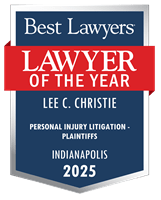Controlling the flow of traffic can take a lot of strategic thinking. For engineers and city planners, keeping things flowing smoothly is a main goal. This not only makes it better to live and drive in those places, it also keeps drivers safer.
Have you been injured in a motor vehicle accident? Christie Farrell Lee & Bell has an experienced team of car accident attorneys who can help you explore your options.
Diverging Diamond Interchange
Greenwood, Indiana just installed the state’s second divergent diamond intersection—the first is up in Fort Wayne. This kind of intersection causes drivers to stop at two lights and merge into opposite lanes to cross each others’ paths. (Confused? Click here.) That means drivers don’t have to turn into oncoming traffic to get onto a highway. At intersections with high instances of turning accidents, these can save lives. However, navigating the intersection means paying attention to signs, at least until you get used to it. They’ve only been in the US since 2009.
Speak with a personal injury lawyer today. Call: 317-488-5500
Signage
Divergent diamonds aren’t the only type of intersection where signage is important. In fact, signage can be important outside intersections too, like if there’s a steep grade ahead on a highway or a curve coming up in the road. Within intersections it’s always important that each entering and exiting street be clearly marked. If important signs are missing, a driver may not appreciate the danger, or the missing sign itself may create danger. A missing stop sign, for example, can do a lot of harm.
Complete a Free Case Evaluation form now
Stoplights
Even in a traditional intersection, a clearly marked left turn lane and even a stoplight signal may be necessary depending on the flow of traffic. Some signals even incorporate new flashing yellow yield arrows for those making a left turn. These are great for signaling to drivers when they should not turn left and when it is safe to do so after the other cars have gone. These new signals help prevent errors and improve the flow of traffic.
These kinds of innovations are part of the safer future we are trying to build for ourselves across the planet. While no system is ever perfect, we are getting better at preventing traffic accidents the longer we drive. It’s hard to remember that the car has only been in common use for about 100 years! As technologies continue to improve, so too will the driver experience.
Click to contact us today
Who is Responsible for an Accident Caused by a Pothole in Indiana?
Potholes are part of life in Indiana, so much so that it can be hard to drive in a straight line without hitting one (or twenty) on any stretch of the road. Not only can hitting a pothole be jarring, but it could also have serious consequences, like causing major damage to your car or an accident that leads to injuries. In 2016 potholes caused enough damage that 30 million Americans had to seek out repairs, and in Indianapolis, one ER doctor is calling on city officials to be better about pothole repair as they are a real concern for patients traveling in an ambulance. With this in mind, you may wonder who is responsible if you need repairs to your car or need to go to a hospital because of a pothole?
Pothole Damage to Your Car
If you hit a pothole and it causes significant damage to your car in Indiana, the Indiana Department of Transportation can be held responsible. In Indianapolis, if you need to get repairs for things like blown out tires or a damaged suspension, you can take your claim directly to the city. There were hundreds of these claims made between January and March of 2018, but of those claims, only one was reimbursed. This is because the city cannot be considered negligent in repairing the pothole if they didn’t know about it, or didn’t have time to fix it. In most cases, potholes are not reported or cause damage in the time before the city can get around to fixing them. The city provides a resource that anyone can use to see if a pothole has been reported or fixed, and how long it took for city employees to make the repair.
Accidents Caused by Potholes
In 2013 the Ohio state government was required to pay over $3 million to the family of a woman who was killed in a pothole-related accident. A semi-truck swerved into oncoming traffic and struck the woman’s car head-on after hitting several potholes. The Ohio Department of Transportation says they didn’t know about the pothole so they didn’t know that they needed to fix it.
This is not the only problem when it comes to determining who is responsible for an accident caused by a pothole. Determining which city department is responsible for the maintenance of the roadway is essential to making a case about a pothole-related car accident in Indiana. The Indiana Department of Transportation is in charge of state and interstate highways, while local roads are maintained by the city or town they pass through. In both Hamilton County and Morgan County, for example, citizens have had a hard time determining who is responsible for the potholes on their local roadways. This is because it’s not always clear whether the county or the city is responsible for pothole repair.
The responsibility for fixing it doesn’t always depend on the location of the pothole, but rather the type of road that the pothole is on. For this reason, it’s best to seek out a good lawyer to help you sort out who is responsible for the maintenance of the roadway as well as other crucial factors. They can help determine who is at fault in the case of an accident that has caused damage to your car, injury, or even death.
Call 317-488-5500 or complete a Free Case Evaluation form



